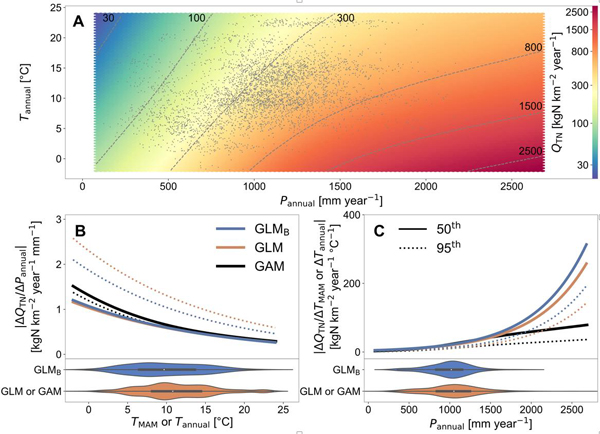Researchers Reveal Evolution of Riverine Nitrogen Loading under Climate Warming
Eutrophication refers to excessive enrichment of nutrients such as nitrogen and phosphorus in waterbodies and it poses a severe challenge to aquatic ecosystems. For instance, it may lead to excessive algal growth, thus having significant impacts on human and ecosystem health. Nitrogen transport from land to water is susceptible to climate change, as changes in precipitation can affect nitrogen leaching from soils, while temperature can impact rates of biochemical reactions of nitrogen.
Previous research has primarily focused on the effects of precipitation changes on riverine nitrogen, revealing that precipitation and riverine nitrogen flux are positively correlated. However, warming can increase microbial activity in soils and sediments, and further enhance rates of denitrification and anaerobic ammonia oxidation. This will result in the release of N2 and N2O (known as a potent greenhouse gas, which were transformed from nitrate and nitrite) into the atmosphere, thereby reducing riverine nitrogen. Currently, the impact of temperature on riverine nitrogen has not been quantified yet, and we still know little about the combined effects of precipitation and temperature in a changing environment.
To address these critical issues, Dr. ZHAO Gang at the Institute of Geographic Sciences and Natural Resources Research (IGSNRR) of the Chinese Academy of Sciences and his collaborators from the Carnegie Institution for Science and the Stanford University conducted quantitative research on the evolution of watershed nitrogen flux under a changing environment. The research findings, with Zhao as the first author, were published in the Proceedings of the National Academy of Sciences (PNAS).
In this study, an interpretable machine learning approach was employed to construct a sensitivity model for riverine nitrogen flux in response to environmental covariates. Results revealed contrasting effects of precipitation and warming on riverine nitrogen flux, indicating the significant influence of denitrification and evapotranspiration processes on watershed nitrogen export.
In addition, using CMIP6 climate model outputs, they predicted the future trajectory of riverine nitrogen under climate change scenarios. While increased precipitation may accelerate soil nitrogen transport to rivers, the rise in temperature causes an increase in denitrification rates, which may offset or even decrease riverine nitrogen flux in most regions.
Reference
Zhao Gang, Julian Merder, Tristan C. Ballard and Anna M. Michalak (2023). Warming may offset impact of precipitation changes on riverine nitrogen loading. Proceedings of the National Academy of Sciences of the United States of America, 120(33), e2220616120.
Author information: https://gzhaowater.github.io/


Download attachments: